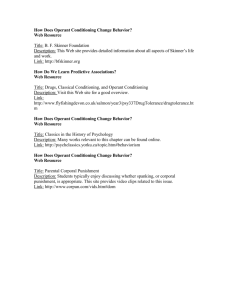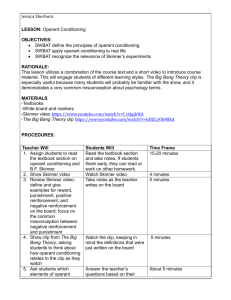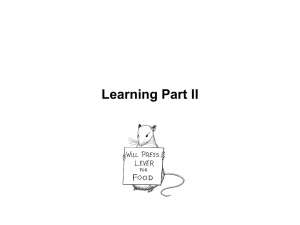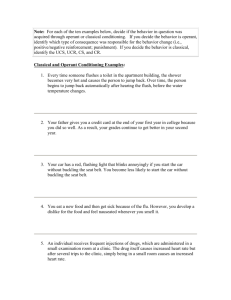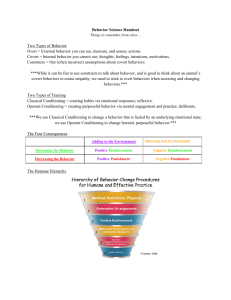EXPLORING PSYCHOLOGY (7th Edition in Modules) David Myers
advertisement
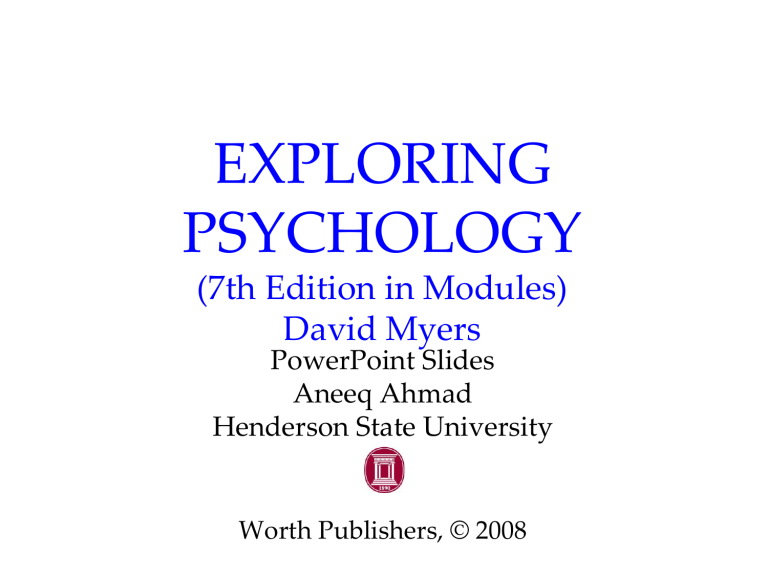
EXPLORING PSYCHOLOGY (7th Edition in Modules) David Myers PowerPoint Slides Aneeq Ahmad Henderson State University Worth Publishers, © 2008 Operant Condtioning Module 19 Learning Operant Conditioning Skinner’s Experiments Extending Skinner’s Understanding Skinner’s Legacy Contrasting Classical & Operant Conditioning Operant & Classical Conditioning 1. Classical conditioning forms associations between stimuli (CS and US). Operant conditioning, on the other hand, forms an association between behaviors and the resulting events. Operant & Classical Conditioning 2. Classical conditioning involves respondent behavior that occurs as an automatic response to a certain stimulus. Operant conditioning involves operant behavior, a behavior that operates on the environment, producing rewarding or punishing stimuli. Skinner’s Experiments Skinner’s experiments extend Thorndike’s thinking, especially his law of effect. This law states that rewarded behavior is likely to occur again. Yale University Library Using Thorndike's law of effect as a starting point, Skinner developed the Operant chamber, or the Skinner box, to study operant conditioning. Walter Dawn/ Photo Researchers, Inc. From The Essentials of Conditioning and Learning, 3rd Edition by Michael P. Domjan, 2005. Used with permission by Thomson Learning, Wadsworth Division Operant Chamber Operant Chamber The operant chamber, or Skinner box, comes with a bar or key that an animal manipulates to obtain a reinforcer like food or water. The bar or key is connected to devices that record the animal’s response. Shaping Shaping is the operant conditioning procedure in which reinforcers guide behavior towards the desired target behavior through successive approximations. Fred Bavendam/ Peter Arnold, Inc. Khamis Ramadhan/ Panapress/ Getty Images A rat shaped to sniff mines. A manatee shaped to discriminate objects of different shapes, colors and sizes. Types of Reinforcers Reinforcement: Any event that strengthens the behavior it follows. A heat lamp positively reinforces a meerkat’s behavior in the cold. Reuters/ Corbis Primary & Secondary Reinforcers 1. Primary Reinforcer: An innately reinforcing stimulus like food or drink. 2. Conditioned Reinforcer: A learned reinforcer that gets its reinforcing power through association with the primary reinforcer. Immediate & Delayed Reinforcers 1. Immediate Reinforcer: A reinforcer that occurs instantly after a behavior. A rat gets a food pellet for a bar press. 2. Delayed Reinforcer: A reinforcer that is delayed in time for a certain behavior. A paycheck that comes at the end of a week. We may be inclined to engage in small immediate reinforcers (watching TV) rather than large delayed reinforcers (getting an A in a course) which require consistent study. Reinforcement Schedules 1. Continuous Reinforcement: Reinforces the desired response each time it occurs. 2. Partial Reinforcement: Reinforces a response only part of the time. Though this results in slower acquisition in the beginning, it shows greater resistance to extinction later on. Ratio Schedules 1. Fixed-ratio schedule: Reinforces a response only after a specified number of responses. e.g., piecework pay. 2. Variable-ratio schedule: Reinforces a response after an unpredictable number of responses. This is hard to extinguish because of the unpredictability. (e.g., behaviors like gambling, fishing.) Interval Schedules 1. Fixed-interval schedule: Reinforces a response only after a specified time has elapsed. (e.g., preparing for an exam only when the exam draws close.) 2. Variable-interval schedule: Reinforces a response at unpredictable time intervals, which produces slow, steady responses. (e.g., pop quiz.) Schedules of Reinforcement Punishment An aversive event that decreases the behavior it follows. Punishment Although there may be some justification for occasional punishment (Larzelaere & Baumrind, 2002), it usually leads to negative effects. 1. 2. 3. 4. Results in unwanted fears. Conveys no information to the organism. Justifies pain to others. Causes unwanted behaviors to reappear in its absence. 5. Causes aggression towards the agent. 6. Causes one unwanted behavior to appear in place of another. Extending Skinner’s Understanding Skinner believed in inner thought processes and biological underpinnings, but many psychologists criticize him for discounting them. Cognition & Operant Conditioning Evidence of cognitive processes during operant learning comes from rats during a maze exploration in which they navigate the maze without an obvious reward. Rats seem to develop cognitive maps, or mental representations, of the layout of the maze (environment). Latent Learning Such cognitive maps are based on latent learning, which becomes apparent only when an incentive is given (Tolman & Honzik, 1930). Intrinsic Motivation Intrinsic Motivation: The desire to perform a behavior for its own sake. Extrinsic Motivation: The desire to perform a behavior due to promised rewards or threats of punishments. Biological Predisposition Photo: Bob Bailey Biological constraints predispose organisms to learn associations that are naturally adaptive. Breland and Breland (1961) showed that animals drift towards their biologically predisposed instinctive behaviors. Marian Breland Bailey Skinner’s Legacy Skinner argued that behaviors were shaped by external influences instead of inner thoughts and feelings. Critics argued that Skinner dehumanized people by neglecting their free will. Falk/ Photo Researchers, Inc . Applications of Operant Conditioning Skinner introduced the concept of teaching machines that shape learning in small steps and provide reinforcements for correct rewards. LWA-JDL/ Corbis In School Applications of Operant Conditioning Reinforcers affect productivity. Many companies now allow employees to share profits and participate in company ownership. At work Applications of Operant Conditioning At Home In children, reinforcing good behavior increases the occurrence of these behaviors. Ignoring unwanted behavior decreases their occurrence. Operant vs. Classical Conditioning
